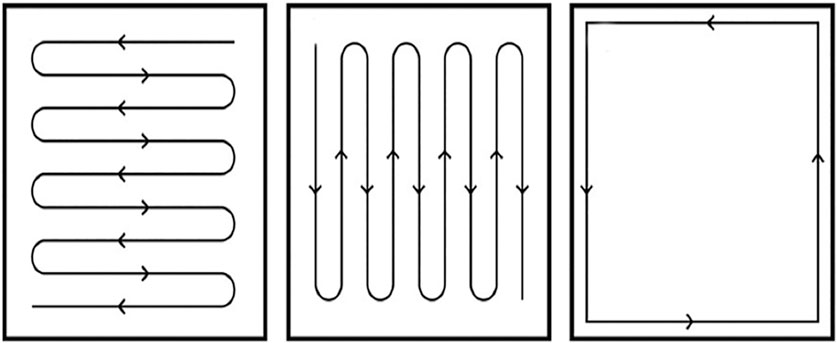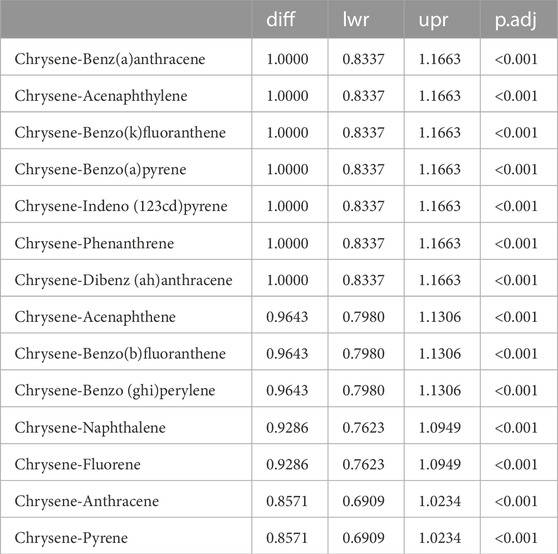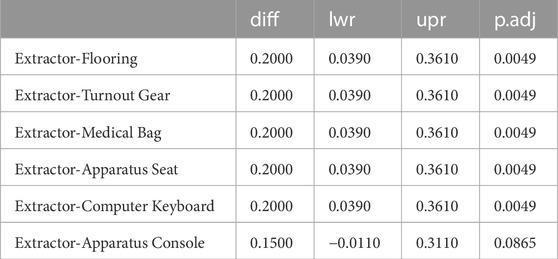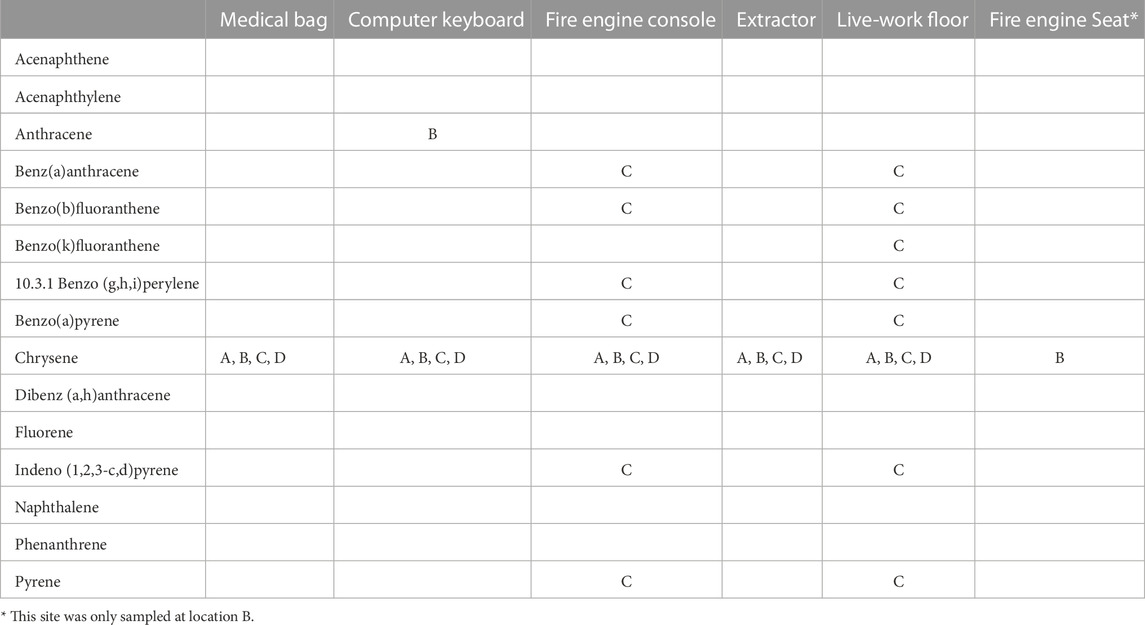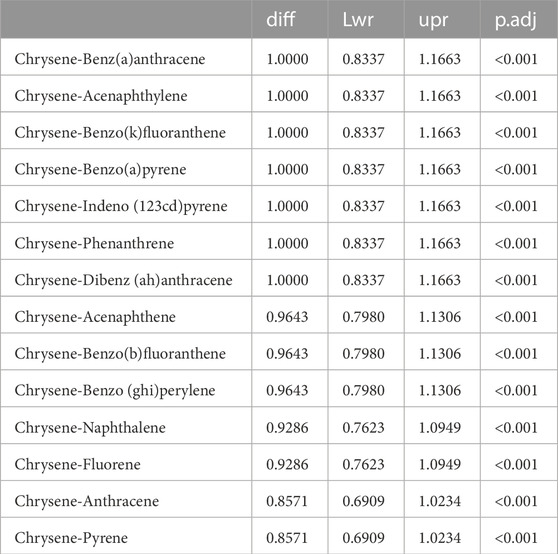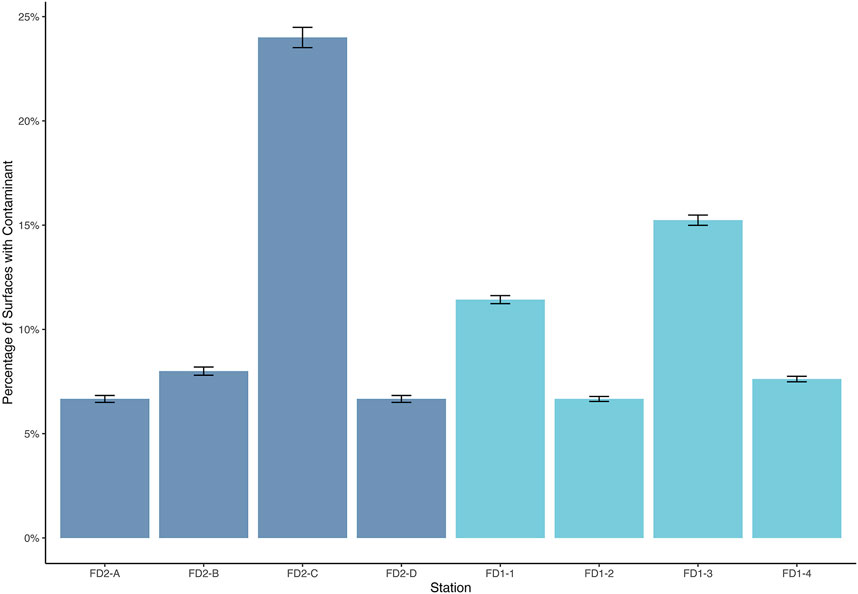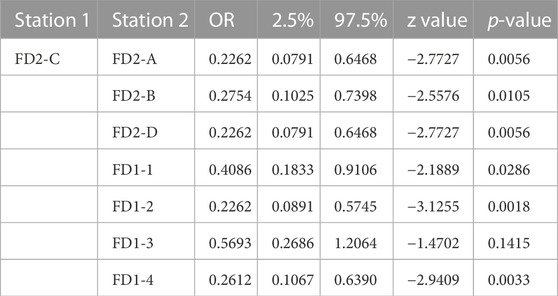- 1Environmental Forensics Laboratory, Department of Human Sciences and Design, Baylor University, Waco, TX, United States
- 2Department of Statistical Science, College of Arts and Sciences, Baylor University, Waco, TX, United States
- 3Center for Global Health and Infectious Disease Research, College of Public Health, University of South Florida, Tampa, FL, United States
Firefighters are exposed to many different biological and chemical contaminants while conducting their work duties, including polyaromatic hydrocarbons or PAHs. PAH compounds are of particular interest in investigations of firefighter health as they have been linked to detrimental health outcomes, including respiratory illnesses and cancers, and are found in high concentrations after fires. Thus, they are quantified in several studies on the occupational exposure of firefighters, and they are the focus of several protocols and technologies aiming to mitigate occupational exposures. Fire departments use standard operation protocols for limiting exposure to occupational health hazards, including exposure to chemical compounds such as PAHs. However, observations of firefighter workflows reveal the potential for major contamination of fire station work-live areas. Herein we make an initial report on the PAHs that firefighters continue to be exposed to after they have finished responding to calls and have potentially doffed their protective gear. The sampling of environmental surfaces in fire apparatus and stations was used as data. This study found that PAHs identified on turnout gear were found in the fire station, suggesting that turnout gear may be vectors of toxic chemicals. Therefore, protocols for decontamination of turnout gear and fire stations should be evaluated to remove PAHs and other chemicals known to impair health. This and further surface sampling studies are needed to better understand the full occupational exposures of firefighters to hazardous chemicals.
1 Introduction
Firefighters are exposed to a wide range of chemical contaminants during active fire suppression operations (Bolstad-Johnson et al., 2000; Blomqvist et al., 2012; Environmental Protection Agency, 2013; Fent et al., 2015; Easter et al., 2016; Fent et al., 2018; Beitel et al., 2020; Banks et al., 2021a). Thus, firefighter contaminated turnout gear may be a vector of toxic chemical transmission to the fire station, from structure and ground fires as well as other non-fire related service calls with chemical exposures. Limited research on fire apparatus environments and exposures to occupants suggests a gap in the research. Engelsman et al. (2019) collected samples from apparatus cabins and was able to detect polycyclic aromatic hydrocarbons (PAHs) in a minimal number of samples. In addition, this study (Engelsman et al., 2019) analyzed samples across fifteen fire stations. It focused on air and wipe samples from the interior and exterior of the fire stations, personal protective equipment (PPE) including clothing, and from within the cabins of fire apparatus. Engelsman et al. (2019) found that elevated concentrations in these environments are associated with the transfer of chemicals from fire suppression operations, increasing exposure risks and increased risk of adverse health effects. Other studies (Sparer et al., 2017; Stec et al., 2018; Shen et al., 2018; Young et al., 2021) support these findings across a spectrum of toxic chemicals, where elevated levels of toxic chemicals were found in fire station dust compared to other occupational and residential settings.
PAH are of particular concern in firefighter occupational exposure studies because they are ubiquitous pollutants that are found in high concentrations during and after fire suppression operations (Keir et al., 2020; Thai et al., 2020; Hoppe-Jones et al., 2021). PAHs are referred to as carcinogens, mutagens, and teratogens. They therefore are known to present a significant risk to human health and wellness (Mallah et al., 2022). PAHs are formed through incomplete combustion of organic materials and are pervasive pollutants on surfaces and in air (Kim et al., 2013). During and after fire suppression operations, firefighters may be exposed to PAHs by absorption through the skin, from cross-transfer of contaminants on PPE to the skin, and through inhalation (Fent et al., 2017). In a pre- and post-exposure study evaluating PAH concentrations, PAH levels were elevated after the fire training scenario on the front of the neck, back of the neck, jaw, and hands of the participating firefighters (Stec et al., 2018). The same study found that PPE items assessed also had elevated PAH levels, including the self-containing breathing apparatus (SCBA), zipflap, shoulder of the turnout gear, gloves, and hood. Whether evaluating ambient air of fire stations, PPE of firefighters, or surface samples found associated with the transmission of PAHs across environments, PAHs and other known chemical contaminants need to be further investigated to identify, quantify, assess risk, and develop protocols to protect firefighters.
Common PAHs produced during structure fires are classified by the International Agency for Research on Cancer (IARC) at various levels of potential carcinogenicity. For examples, there are the classification of benzo [a]pyrene as carcinogenic to humans (Group 1), classification of dibenz (a,h)anthracene, chrysene, and anthracene as probably or possibly carcinogenic to humans (Group 2A or 2B), and acenaphthene, fluorene, phenanthrene, and pyrene as chemicals of concern but current evidence is inadequate in humans or limited in experimental animals (Group 3) (Palmer, 2011). Nearly all fires will produce other potentially carcinogenic aromatic hydrocarbons, such as benzene and chrysene. Regardless of the IARC classifications, acute health effects of PAHs depend on the length of time of exposure, the concentration of PAHs during exposure, the toxicity of the PAHs, and the route of exposure (inhalation, ingestion, or skin absorption). For chronic occupational exposures, mixtures of PAHs and other workplace chemicals are associated with a series of health problems including increased risk of skin, lung, bladder, and gastrointestinal cancers (Kim et al., 2013). Additionally, external factors may affect health impacts such as pre-existing health conditions and age. For instance, PAHs have been reported to impair lung function in asthmatics and thrombotic effects in those affected by coronary heart disease (ACGIH, 2005). Occupational exposures to high levels of chemical pollutant mixtures containing PAHs are known to result in symptoms such as eye irritation, nausea and vomiting, and inflammation (Unwin et al., 2006; Kim et al., 2013). PAHs also have the potential to interfere with the hormone systems, effecting reproductive and immune function, cataracts, kidney, and liver damage, and gene mutation cell damage (García-Suástegui et al., 2011; Yang et al., 2021). Unfortunately, most studies of PAHs are focused on chemical mixtures and not isolated PAH, making it difficult to isolate the effect of individual PAHs (Kim et al., 2013). It is still widely accepted that PAHs have carcinogenic potential based on evidence from epidemiological studies identified in a meta-analysis focused on cancer risk after exposure to PAHs (Armstrong et al., 2003).
With some of the highest rates of injuries and illnesses across all occupations, firefighters are at elevated risk for cancers and incidences of respiratory, digestive, lymphatic, skeletal, and reproductive health problems (Lemasters et al., 2006; Daniels et al., 2014; Daniels et al., 2015). Thus the evolution of protocols to protect firefighters from these contaminants continues (McGuire-Wolfe, 2020). Currently, firefighters rely heavily on PPE to protect them during fire suppression operations and other service calls, and to mitigate direct exposures to toxic chemical compounds. However, firefighters are continually at risk of cross-contamination through donning and doffing PPE, handling turnout gear during decontamination protocols, and passively off-gassing in fire stations. While firefighters expect the risk of exposure while responding to service calls, they are vulnerable in their fire station where they work, sleep, cook, and live while on duty. This study aims to investigate, through surveillance, fire station contamination of environmental surfaces. This study will evaluate PAH chemicals known to be found at structure fire sites and on firefighter PPE to discern their potential transmission to fire stations, increasing risk of exposure of firefighters.
2 Materials and methods
2.1 Materials
Dichloromethane (DCM), disposable sampling templates (10 cm × 10 cm), n-hexane, sterile cellulosic gauze pads (3 in x 3 in), and syringe filters (PTFE, 0.45 μm) were purchased through Fisher Scientific. CLPS-B PAH Mix (2,000 μg/mL in DCM:benzene), anthracene-d10 (1,000 μg/mL in DCM), benzo(a)pyrene-d12 (1,000 μg/mL in DCM), and phenanthrene-d10 (1,000 μg/mL in DCM) from Spex® CertiPrep were purchased through Fisher Scientific. Acenaphthene-d10 (2,000 μg/mL in DCM) and naphthalene-d8 (2,000 μg/mL in DCM) from MilliporeSigma™ Supelco™ were also purchased through Fisher Scientific.
2.2 Environmental sampling
Two fire departments located in the southern region of the United States provided access for environmental sampling of polycyclic aromatic hydrocarbons (PAHs). This sampling was conducted parallel to microbial sampling detailed in a previous report (Barr et al., 2021). Fire Department 1 (FD1) provided access to one fire station for repeated sampling over 4 weeks. Fire Department 2 (FD2) provided access to four fire stations for incidental sampling on 1 day.
The following surfaces were sampled: medical bag (nylon), back seat (unknown synthetic woven textile) and console (unknown polymer) in the fire engine; extractor (stainless steel & glass) and contaminated turnout gear outer shell (Kevlar®/Nomex®) in the fire station garage; and the computer keyboard (acrylonitrile butadiene styrene) and entryway floor (PVC safety sheet flooring) in the live-work area of the fire station. These surfaces were chosen because they were either high-touch or high-use objects within the fire station. In total there were 159 samples collected.
A wipe protocol (Figure 1) was used to collect samples. Wipes—Sterile cellulosic gauze pads wet with 2 mL of n-hexane—Were used with a disposable sampling template to sample designated areas of each surface. Within the template, the wetted side of the gauze was pressed to wipe down firmly at an upper corner of the textile sample. An “S” shape motion (as many as needed) is made to cover the entire textile (Figure 1A). The gauze wipe was folded in half, keeping dirty side in. Then, the gauze was used to wipe in an “S” shape motion perpendicular to the first wipe ensuring the entire textile sample is covered (Figure 1B). The gauze wipe is folded in half again, keeping dirty side in, and a third wipe focusing on the edges of the specimen is performed (Figure 1C). The wipe was folded again, with the sample side folded in, to place the folded wipe into an extraction vessel while avoiding contact with other surfaces and the upper portion of the extraction vessel. New disposable gloves and tweezers cleaned with solvents were used to handle each new gauze wipe and textile specimen pair, with care to avoid touching anything other than these items. Wipe samples were placed in amber vials, labeled, and stored in a −80°C freezer until the time of extraction.
2.3 Samples analysis
Wipe samples were cut into three portions (triplicates) for PAH extraction. PAHs were extracted from samples following sonication procedures adapted from previously reported methods. Stec et al. (2018), Beitel et al. (2020), Fent et al. (2020), Mayer et al. (2020). Wipes were placed in extraction vessels with 8 mL of DCM. The vessels were screwed closed and then sonicated for 60 min with no heat. Immediately after sonication, the extraction vessels were vented in a hood until they reached room temperature. Extracts were filtered through 0.45 μm PTFE syringe filters into vessels for evaporation. The extraction vessels and filters were rinsed with excess extraction solvent and transferred to the evaporation vessels too. After evaporation, samples are stored in 1 mL DCM in amber chromatography vials to await gas chromatography-mass spectrometry (GC/MS) analysis.
Prior to analysis by GC/MS, five deuterated PAHs were added to each sample at 2 ppm to serve as internal standards: acenaphthene-d10, anthracene-d10, benzo(a)pyrene-d12, naphthalene-d8, and phenanthrene-d10. The internal standards were also added to an external calibration curve prepared from a 2,000 ppm CLSP-B ampule diluted in dichloromethane. Dichloromethane blanks were run regularly between extraction samples to prevent and monitor carry-over.
GC/MS analysis was completed with a Thermo Trace 1310 Gas Chromatograph coupled to an ISQ 7000 single quadrupole mass spectrometer (Thermo Scientific, Austin, TX, United States) and Thermo Scientific Dionex Chromeleon 7 Data System Version 7.3 (60919) using a 60 m column, 1 μL injection volume, and splitless mode. The inlet temperature of the GC was set to 300°C and the temperature ramped as follows: hold at 50°C for 1 min, ramp 20°C/min up to 250°C, ramp 10°C/min up to 330°C, hold at 330°C for 1 min. MS acquisition ran in positive mode with an electron ionization (EI) source temperature of 300°C. Peaks in the raw data were manually selected for identification and matched against the NIST database of EI spectra. Recorded limits of quantification (LOQ) are: acenaphthene (10 ppb), acenaphthylene (10 ppb), anthracene (100 ppb), benz(a)anthracene (10 ppb), benzo(b)fluoranthene (100 ppb), benzo(k)fluoranthene (5 ppm), benzo (g,h,i)perylene (10 ppm), benzo(a)pyrene (250 ppb), chrysene (25 ppb), dibenz (a,h)anthracene (2 ppm), fluorene (10 ppb), indeno (1,2,3-c,d)pyrene (10 ppm), naphthalene (50 ppb), phenanthrene (50 ppb), and pyrene (10 ppb).
2.4 Data analysis
PAH concentrations were assigned against the external standards for each extraction. Then, the triplicates of each wipe sample were combined with the presence of PAHs being defined as a positive result on at least one of the three samples. FD1 in week 1 had more observed collection sites than the other departments/weeks. The additional observations were from various parts of the same site (e.g., back of drum and drum). So, these samples were combined into a single observation, with presence meaning any of the samples were positive.
ANOVA was utilized to compare average presence of chemicals across sites and departments. Tukey HSD pairwise comparisons were utilized if the result was statistically significant to identify pairs that differed. Logistic regression was performed to model the binary outcome of presence of chemical and odds ratios comparing groups to a reference category reported. In some instances, data sparsity (subgroups with either no chemical present or chemicals present in every sample) made logistic regression infeasible. So, the ANOVA results were the only option.
3 Results
3.1 Fire department 1 (FD1)
Table 1 represents the four discrete sampling events (1, 2, 3, and 4) over time at the same fire station in FD1. All sampled locations at the FD1 station had detectable levels of chrysene at every time point. Several locations had additional PAHs. The sampled console had detected levels of anthracene at week 3, and pyrene at weeks 1 and 3 sampling events. The sampled extractor had detectable levels of fluorene, naphthalene, and pyrene at the week 1 sampling event. Acenaphthene, anthracene, benzo(b)fluoranthene, benzo (g,h,i)perylene, dibenz (a,h)anthracene, fluorene, naphthalene, and pyrene were detected at the week 3 sampling event. Anthracene was also found at this location at the week 4 sampling event. Acenaphthylene, benz(a)anthracene, benzo(k)fluoranthene, benzo(a)pyrene, indeno (1,2,3-c,d)pyrene, and phenanthrene were probed for, but not detected at any surface sampling site of the FD1 station at concentrations above our limits of detection. When comparing all four sampling events, no significance was found.
Table 2 illustrates that the detection of chrysene is statistically different than the detection of all other PAHs (p < 0.0001) using Tukey HSD to adjust for multiple comparisons. The next largest differences are between anthracene and pyrene (which were both detected 4 times) and each PAH that was not detected. However, these differences are not statistically significant (p = 0.186).
There are significant differences in observed presences by site (ANOVA F-test, p = 0.0011). Table 3 shows pairwise post hoc comparisons with p-values < 0.5. All comparisons shown are significant at 0.05 level except the Extractor-Apparatus comparison (p = 0.086).
3.2 Fire department FD2
The results of Table 4 represent incidental sampling across four different fire stations (A, B, C, D) of FD2 on the same day. All sampled locations had detectable levels of chrysene at every station of FD2. We also detected additional PAHs at several stations and surface sampling locations of FD2. Anthracene was detected on the computer of FD2-B. Benz(a)anthracene, benzo(b)fluoranthene, benzo (g,h,i)perylene, benzo(a)pyrene, indeno (1,2,3-c,d)pyrene, and pyrene were detected on the fire engine console of FD2-C. Benz(a)anthracene, benzo(b)fluoranthene, benzo(k)fluoranthene, benzo (g,h,i)perylene, benzo(a)pyrene, indeno (1,2,3-c,d)pyrene, and pyrene were detected on FD2-C’s entryway floor at significant concentrations. Acenaphthene, acenaphthylene, dibenz (a,h)anthracene, fluorene, naphthalene, and phenanthrene were probed for but not detected at any FD2 station at significant concentrations.
Tukey HSD adjusted pairwise comparisons show significant differences between the incidence of chrysene and all other PAHs detected (Table 5).
There were no significant differences in observed PAH presence by site (p = 0.1008), but there was a statistically significant difference within the stations. FD2-C had a statistically higher count of PAH observations (p = 0.000981) compared to all other stations as shown in Table 6.
3.3 Comparison across the fire departments
The overall percentage of tests for which any chemical was found by station (and week for FD1) is shown in Figure 2. The station factor is statistically significant (p = 0.007) With FD2’s Station C as the reference group, all other station/weeks have a statistically significant reduction in odds of a chemical detection except for FD1-3 (Table 7).
4 Discussion
PAH compounds are of particular interest in investigations of firefighter health and occupational exposure studies as they are ubiquitous pollutants which are found in especially high concentrations after fires (McMahon and Tsoukalas, 1978; Vergnoux et al., 2011; Baxter et al., 2014; Mansilha et al., 2014; Keir et al., 2020; Fent et al., 2020; Banks et al., 2021a; Hoppe-Jones et al., 2021). Exposures to PAHs have been linked to detrimental human health outcomes. Generalities about PAH exposure cannot be drawn as the type of PAH, exposure route (dermal absorption, inhalation, and ingestion), length of exposure, amount of exposure and biological susceptibility factors impact the levels of concern; but acute exposures to PAHs—Such as through exhaust gases and food—Have been linked to mucous membrane irritation, skin irritation, vomiting, confusion, and diarrhea (Agency for Toxic Substances and Disease Registry (ATSDR), 2023). Chronic exposures to PAHs have additionally been linked to asthma, chronic obstructive pulmonary disease (COPD), and a variety of cancers (Agency for Toxic Substances and Disease Registry (ATSDR), 2023; Centers for Disease Control and Prevention, 2013). Observations of firefighter protocols and workflow elucidate that their occupation lends them to acute and chronic exposures to PAHs, acute exposures sourced from the fires that they combat. Chronic exposures are sourced from acute exposures throughout a firefighter’s career, and from their interaction with contaminated textiles and surfaces.
We previously published our observations of firefighter behaviors at FD1 and FD2 during the time of this surface sampling (Barr et al., 2021). At each station observed, firefighters entered their stations and went immediately to file reports using their station computers prior to washing their hands. When completed, handwashing practices were not consistent between stations or within them. Additionally, we observed one station respond to multiple calls before returning to the station, filing reports on their station computers, and then washing their hands. So, it is possible that PAHs from each call that this station responded to accumulated on the firefighters until they were deposited on the computer keyboard. The standard operating protocols for exposure control and general cleaning were also inconsistent between the departments or stations. The FD1 station had protocols that included mopping entryway floors daily. Alternatively, the FD2 stations used disinfecting mats on the entryway floors, but each station did not use them correctly. So, it is possible that the entryway floor mats could serve as a vector for PAHs in that environment. In summation, the handwashing behaviors and exposure control procedures observed did not appear sufficient for limiting the contamination of fire station live-work areas.
In this study, the PAH chrysene was found at every sampled site where detectable levels of PAHs were observed at both fire departments. Chrysene’s detection was found to be significantly greater than that of the other probed for PAHs (Tables 2 and 5). Since chrysene is one of the most common PAHs and is produced as smoke during incomplete combustion of coal, gasoline, garbage, animal, and plant materials, its presence is not surprising (Biswas and Ghosh, 2014). Chrysene and several of its isomers are classified as “probably carcinogenic” and “reasonably anticipated to be” carcinogenic to humans by several organizations (Gehle, 2009; National Toxicology Program, 2021; American Cancer Society, 2022). Chrysene’s significant presence at every site sampled, at every fire station sampled exemplifies the problem of hazardous contamination in the live-work spaces of firefighters. It is important to note that other PAHs used in this study are listed by the Environmental Protection Agency (EPA) as priority chemicals, including acenaphthene, acenaphthylene, anthracene, benzo (g,h,i)perylene, fluorene, phenanthrene, and pyrene. Other studies finding similar combinations of PAHs in smoke exposure (Fabian et al., 2014), PPE and skin (Fent et al., 2017; Stec et al., 2018; Mayer et al., 2019; Mayer et al., 2020), and air and surfaces (Sparer et al., 2017; Fent et al., 2018; Engelsman et al., 2019; Keir et al., 2020; Shinde, 2020; Banks et al., 2021b) begin to indicate the initial ambient exposures, turnout contamination and the transmission to fire stations.
A second concern of hazardous contamination in the live-work spaces elucidated by this study is that the extractor was the most contaminated site sampled at FD1 (Table 1), presenting a concern that the extractor is cross-contaminating turnout sets. Since we observed no significant difference between the contamination in the fire apparatus and the extractor (Table 3), contamination of the extractor most likely came from the firefighter gear worn in the apparatus from fire calls, transferred from the service call site, and placed into the extractor for cleaning. Being able to detect PAHs in the empty extractor is likely due to the regular washing of firefighter uniforms and turnout gear without a standard protocol for decontaminating the extractor after each use. Considering that every firefighter’s uniform, turnout gear or clothing may go through a cleaning in the extractor, proper decontamination of the extractor is imperative to break the chain and prevent it from being a vector of hazardous exposure after the cleaning, disinfecting, and decontaminating process is complete.
A third factor of fire station contamination elucidated by this study is the variability of contamination of the station regardless of the frequency of fire calls (Figure 2; Tables 6, 7). FD2-A had significantly more fire service call frequencies than the other FD2 stations as previously reported (Barr et al., 2021). This finding brings into question standard protocols for cleaning and decontamination of fire stations. FD2-C had only 31% of the fire service calls yet was significantly more contaminated with sampled PAHs than the other FD2 stations. Further investigation is needed to determine factors contributing to variability of PAH deposits in the fire station environment.
There are several PAHs that we probed for but did not identify above the limit of our protocols. This does not necessarily mean that the PAHs were not on the sampled locations because our research protocols have limitations. Chemical sampling and analysis are often optimized to the levels/concentrations/amounts of chemicals to be sampled. Unfortunately, we lacked an awareness of the contamination levels before surface sampling. So, our surface sampling and analysis methods may not be well optimized. For example, we sampled the bottom of the medical bag for PAHs but sampling the side or top of the bag may have led to PAH detection. Also, our evaporation process (for the concentration of sample extractions) may have resulted in a loss of PAHs prior to GC/MS analysis. This study also has limited surface sampling sites and number of stations in its data. Despite these limitations, this preliminary study certainly illustrates the need to further surveil chemical contamination levels of the live-work spaces in fire stations.
There are more PAHs and other carcinogenic chemical compounds in fire station live-work areas that are not covered in this or similar studies. Environmental sampling and chemical surveillance should be comprehensive at fire stations to attain a full picture of the current occupational hazard and exposure levels for firefighters. A full assessment can lead to the development and implementation of mitigations and protocols to limit and contain risks to the health of this important population of our society.
In conclusion, the PAHs studied are listed as priority chemicals by the EPA. Combinations are found in fire site smoke and ambient air in fire stations; on PPE, skin, and environmental surfaces, which represents transmission from the source fire to fire stations via firefighters and contaminated turnout gear. Observed protocols for minimizing exposure risks such as including particulate trap mats at entryways, housekeeping, and handwashing, did not appear sufficient for limiting contamination of fire station live-work areas. Consistent facility decisions along with additional training and an informational campaign may increase compliance with processes that will reduce exposure risks. Among the environmental samples collected, the most contaminated site was the extractor. Proper decontamination of the extractor between loads is recommended to break the chain of transmission, preventing potential cross-contamination of turnouts during the decontamination process. The variability of fire station contamination was not dependent on the service call frequency. Variability may be due to the inconsistency of chemical toxicants in different fires, differences in housekeeping, or other factors not considered. Further investigation is needed to determine contributing factors of PAH deposits on surfaces in fire stations.
Data availability statement
The original contributions presented in the study are included in the article/supplementary material, further inquiries can be directed to the corresponding author.
Author contributions
KB and DH contributed to the conceptualization and design of the study. KB, DH, and DW developed the methodology. KB and DH conducted sample collection. FE, DH, SP, AW, and DW contributed to sample analysis. RS and DW performed the formal analysis. KB, FE, DH, RS, AW, and DW contributed to the original draft preparation. All authors contributed to the article and approved the submitted version.
Funding
Funding for this study was provided by Baylor University.
Acknowledgments
We would like to thank the fire departments who participated in this study. We would also like to thank Dr. Alejandro J. Ramirez for training and support for the GC/MS in Baylor’s Mass Spectrometry Center.
Conflict of interest
The authors declare that the research was conducted in the absence of any commercial or financial relationships that could be construed as a potential conflict of interest.
Publisher’s note
All claims expressed in this article are solely those of the authors and do not necessarily represent those of their affiliated organizations, or those of the publisher, the editors and the reviewers. Any product that may be evaluated in this article, or claim that may be made by its manufacturer, is not guaranteed or endorsed by the publisher.
References
Acgih (2005). Polycyclic aromatic hydrocarbons (PAHs) biologic exposure indices (BEI). Cincinnati, OH: American Conference of Governmental Industrial Hygienists. ACGIH.
Agency for Toxic Substances and Disease Registry (ATSDR) (2023). ToxFAQs™ for Polycyclic Aromatic Hydrocarbons (PAHs). Available at: https://wwwn.cdc.gov/TSP/ToxFAQs/ToxFAQsDetails.aspx?faqid=121&toxid=25.
American Cancer Society (2022). Known and probable human carcinogens. Available at: https://www.cancer.org/healthy/cancer-causes/general-info/known-and-probable-human-carcinogens.html (Accessed July 8, 2022).
Armstrong, B., Hutchinson, E., and Fletcher, T. (2003). Cancer risk following exposure to polycyclic aromatic hydrocarbons (PAHs): A meta-analysis. London, UK: London School of Hygiene and Tropical Medicine.
Banks, A. P. W., Thai, P., Engelsman, M., Wang, X., Osorio, A. F., and Mueller, J. F. (2021a). Characterising the exposure of Australian firefighters to polycyclic aromatic hydrocarbons generated in simulated compartment fires. Int. J. Hyg. Environ. Health 231, 113637. doi:10.1016/j.ijheh.2020.113637
Banks, A. P. W., Wang, X., Engelsman, M., He, C., Osorio, A. F., and Mueller, J. F. (2021b). Assessing decontamination and laundering processes for the removal of polycyclic aromatic hydrocarbons and flame retardants from firefighting uniforms. Environ. Res. 194, 110616. doi:10.1016/j.envres.2020.110616
Barr, K. L., Sturdivant, R. X., Williams, D. N., and Harris, D. (2021). Bacteria associated with healthcare-associated infections on environmental samples obtained from two fire departments. Int. J. Environ. Res. public health 18, 11885. doi:10.3390/ijerph182211885
Baxter, C. S., Hoffman, J. D., Knipp, M. J., Reponen, T., and Haynes, E. N. (2014). Exposure of firefighters to particulates and polycyclic aromatic hydrocarbons. J. Occup. Environ. Hyg. 11, D85–D91. doi:10.1080/15459624.2014.890286
Beitel, S. C., Flahr, L. M., Hoppe-Jones, C., Burgess, J. L., Littau, S. R., Gulotta, J., et al. (2020). Assessment of the toxicity of firefighter exposures using the PAH CALUX bioassay. Environ. Int. 135, 105207. doi:10.1016/j.envint.2019.105207
Blomqvist, P., Mcnamee, M., Andersson, P., and Lönnermark, A. (2012). Polycyclic aromatic hydrocarbons (PAHs) quantified in large-scale fire experiments. Fire Technol. 48, 513–528. doi:10.1007/s10694-011-0242-9
Bolstad-Johnson, D. M., Burgess, J. L., Crutchfield, C. D., Storment, S., Gerkin, R., and Wilson, J. R. (2000). Characterization of firefighter exposures during fire overhaul. AIHAJ - Am. Industrial Hyg. Assoc. 61, 636–641. doi:10.1080/15298660008984572
Centers for Disease Control and Prevention (2013). Polycyclic Aromatic Hydrocarbons (PAHs) Factsheet. Atlanta, GA: Centers for Disease Control and Prevention.
Daniels, R. D., Bertke, S., Dahm, M. M., Yiin, J. H., Kubale, T. L., Hales, T. R., et al. (2015). Exposure-response relationships for select cancer and non-cancer health outcomes in a cohort of US firefighters from San Francisco, Chicago and Philadelphia. Occup. Environ. Med. 72, 699–706. doi:10.1136/oemed-2014-102671
Daniels, R. D., Kubale, T. L., Yiin, J. H., Dahm, M. M., Hales, T. R., Baris, D., et al. (2014). Mortality and cancer incidence in a pooled cohort of US firefighters from San Francisco, Chicago and Philadelphia. Occup. Environ. Med. 71, 388–397. doi:10.1136/oemed-2013-101662
Easter, E., Lander, D., and Huston, T. (2016). Risk assessment of soils identified on firefighter turnout gear. J. Occup. Environ. Hyg. 13, 647–657. doi:10.1080/15459624.2016.1165823
Engelsman, M., Snoek, M. F., Banks, A. P. W., Cantrell, P., Wang, X., Toms, L.-M., et al. (2019). Exposure to metals and semivolatile organic compounds in Australian fire stations. Environ. Res. 179, 108745. doi:10.1016/j.envres.2019.108745
Environmental Protection Agency (2013). EPA/HUD model refresher lead dust sampling technician training course. Washington, D, C: EPA.
Fent, K. W., Evans, D. E., Booher, D., Pleil, J. D., Stiegel, M. A., Horn, G. P., et al. (2015). Volatile organic compounds off-gassing from firefighters' personal protective equipment ensembles after use. J. Occup. Environ. Hyg. 12, 404–414. doi:10.1080/15459624.2015.1025135
Fabian, T. Z., Borgerson, J. L., Gandhi, P. D., Baxter, C. S., Ross, C. S., Lockey, J. E., et al. (2014). Characterization of firefighter smoke exposure. Fire Technol. 50, 993–1019. doi:10.1007/s10694-011-0212-2
Fent, K. W., Alexander, B., Roberts, J., Robertson, S., Toennis, C., Sammons, D., et al. (2017). Contamination of firefighter personal protective equipment and skin and the effectiveness of decontamination procedures. J. Occup. Environ. Hyg. 14, 801–814. doi:10.1080/15459624.2017.1334904
Fent, K. W., Evans, D. E., Babik, K., Striley, C., Bertke, S., Kerber, S., et al. (2018). Airborne contaminants during controlled residential fires. J. Occup. Environ. Hyg. 15, 399–412. doi:10.1080/15459624.2018.1445260
Fent, K. W., Toennis, C., Sammons, D., Robertson, S., Bertke, S., Calafat, A. M., et al. (2020). Firefighters' absorption of PAHs and VOCs during controlled residential fires by job assignment and fire attack tactic. J. Expo. Sci. Environ. Epidemiol. 30, 338–349. doi:10.1038/s41370-019-0145-2
García-Suástegui, W. A., Huerta-Chagoya, A., Carrasco-Colín, K. L., Pratt, M. M., John, K., Petrosyan, P., et al. (2011). Seasonal variations in the levels of PAH-DNA adducts in young adults living in Mexico City. Mutagenesis 26, 385–391. doi:10.1093/mutage/geq104
Gehle, K. (2009). Agency for Toxic Substances and Disease Registry (ATSDR) case studies in environmental medicine toxicity of polycyclic aromatic hydrocarbons (PAHs). Atlanta: USA Department of Health and Human Services Agency for Toxic Substances and Disease Registry Division of Toxicology and Environmental Medicine.
Hoppe-Jones, C., Griffin, S. C., Gulotta, J. J., Wallentine, D. D., Moore, P. K., Beitel, S. C., et al. (2021). Evaluation of fireground exposures using urinary PAH metabolites. J. Expo. Sci. Environ. Epidemiol. 31, 913–922. doi:10.1038/s41370-021-00311-x
Keir, J. L. A., Akhtar, U. S., Matschke, D. M. J., White, P. A., Kirkham, T. L., Chan, H. M., et al. (2020). Polycyclic aromatic hydrocarbon (PAH) and metal contamination of air and surfaces exposed to combustion emissions during emergency fire suppression: Implications for firefighters' exposures. Sci. Total Environ. 698, 134211. doi:10.1016/j.scitotenv.2019.134211
Kim, K.-H., Jahan, S. A., Kabir, E., and Brown, R. J. C. (2013). A review of airborne polycyclic aromatic hydrocarbons (PAHs) and their human health effects. Environ. Int. 60, 71–80. doi:10.1016/j.envint.2013.07.019
Lemasters, K. G., Genaidy, M. A., Succop, M. P., Deddens, M. J., Sobeih, M. T., Barriera-Viruet, M. H., et al. (2006). Cancer risk among firefighters: A review and meta-analysis of 32 studies. J. Occup. Environ. Med. 48, 1189–1202. doi:10.1097/01.jom.0000246229.68697.90
Mayer, A. C., Fent, K. W., Bertke, S., Horn, G. P., Smith, D. L., Kerber, S., et al. (2019). Firefighter hood contamination: Efficiency of laundering to remove PAHs and FRs. J. Occup. Environ. Hyg. 16, 129–140. doi:10.1080/15459624.2018.1540877
Mallah, M. A., Changxing, L., Mallah, M. A., Noreen, S., Liu, Y., Saeed, M., et al. (2022). Polycyclic aromatic hydrocarbon and its effects on human health: An overeview. Chemosphere Oxf. 296, 133948. doi:10.1016/j.chemosphere.2022.133948
Mansilha, C., Carvalho, A., Guimarães, P., and Espinha Marques, J. (2014). Water quality concerns due to forest fires: Polycyclic aromatic hydrocarbons (PAH) contamination of groundwater from mountain areas. J. Toxicol. Environ. Health, Part A 77, 806–815. doi:10.1080/15287394.2014.909301
Mayer, A. C., Horn, G. P., Fent, K. W., Bertke, S. J., Kerber, S., Kesler, R. M., et al. (2020). Impact of select PPE design elements and repeated laundering in firefighter protection from smoke exposure. J. Occup. Environ. Hyg. 17, 505–514. doi:10.1080/15459624.2020.1811869
Mcguire-Wolfe, C. (2020). Firefighters fighting germs - evaluation of a disinfecting protocol for use in the fire service. Infect. control Hosp. Epidemiol. 41, s519–s520. doi:10.1017/ice.2020.1202
Mcmahon, C. K., and Tsoukalas, S. N. (1978). “Polynuclear aromatic hydrocarbons in forest fire smoke,” in Carcinogenesis. Editors P. W. Jones, and R. I. Freudenthal (New York: Raven Press), 61–73.
National Toxicology Program (2021). Report on carcinogens. 15. Research Triangle Park, NC: U.S. Department of Health and Human Services, Public Health Service.
Palmer, K. (2011). “IARC monographs on the evaluation of carcinogenic risks to humans,” in Painting, firefighting and shiftwork. International agency for research on cancer (Oxford, UK: Oxford University Press).
Shen, B., Whitehead, T. P., Gill, R., Dhaliwal, J., Brown, F. R., Petreas, M., et al. (2018). Organophosphate flame retardants in dust collected from United States fire stations. Environ. Int. 112, 41–48. doi:10.1016/j.envint.2017.12.009
Shinde, A. D. (2020). Analysis of fireground contamination of firefighting turnouts using headspace sampling-gas chromatography-mass spectrometry (HS-GC-MS). Ann Arbor, Michigan: ProQuest Dissertations Publishing.
Sparer, E. H., Prendergast, D. P., Apell, J. N., Bartzak, M. R., Wagner, G. R., Adamkiewicz, G., et al. (2017). Assessment of ambient exposures firefighters encounter while at the fire station: An exploratory study. J. Occup. Environ. Med. 59, 1017–1023. doi:10.1097/jom.0000000000001114
Stec, A. A., Dickens, K. E., Salden, M., Hewitt, F. E., Watts, D. P., Houldsworth, P. E., et al. (2018). Occupational exposure to polycyclic aromatic hydrocarbons and elevated cancer incidence in firefighters. Sci. Rep. 8, 2476. doi:10.1038/s41598-018-20616-6
Thai, P. K., Banks, A. P. W., Toms, L.-M. L., Choi, P. M., Wang, X., Hobson, P., et al. (2020). Analysis of urinary metabolites of polycyclic aromatic hydrocarbons and cotinine in pooled urine samples to determine the exposure to PAHs in an Australian population. Environ. Res. 182, 109048. doi:10.1016/j.envres.2019.109048
Unwin, J., Cocker, J., Scobbie, E., and Chambers, H. (2006). An assessment of occupational exposure to polycyclic aromatic hydrocarbons in the UK. Ann. Occup. Hyg. 50, 395–403. doi:10.1093/annhyg/mel010
Vergnoux, A., Malleret, L., Asia, L., Doumenq, P., and Theraulaz, F. (2011). Impact of forest fires on PAH level and distribution in soils. Environ. Res. 111, 193–198. doi:10.1016/j.envres.2010.01.008
Yang, L., Zhang, H., Zhang, X., Xing, W., Wang, Y., Bai, P., et al. (2021). Exposure to atmospheric particulate matter-bound polycyclic aromatic hydrocarbons and their health effects: A review. Int. J. Environ. Res. public health 18, 2177. doi:10.3390/ijerph18042177
Keywords: polycyclic aromatic hydrocarbons, PAH, cancer, environmental surfaces, turnout gear, chemical contaminants, occupational exposures, vector of transmission
Citation: Williams DN, El Hay F, Wijesinghe A, Pulluri S, Sturdivant RX, Barr KL and Harris DD (2023) Chemical compounds associated with increased risk for cancer incidence found in environmental samples obtained from two fire departments. Front. Mater. 10:1162730. doi: 10.3389/fmats.2023.1162730
Received: 09 February 2023; Accepted: 13 July 2023;
Published: 27 July 2023.
Edited by:
Wei Wu, Ji Hua Laboratory (JHL), ChinaReviewed by:
Joanna Rakowska, Main School of Fire Service (SGSP), PolandRajesh Sunasee, State University of New York College at Plattsburgh, United States
Copyright © 2023 Williams, El Hay, Wijesinghe, Pulluri, Sturdivant, Barr and Harris. This is an open-access article distributed under the terms of the Creative Commons Attribution License (CC BY). The use, distribution or reproduction in other forums is permitted, provided the original author(s) and the copyright owner(s) are credited and that the original publication in this journal is cited, in accordance with accepted academic practice. No use, distribution or reproduction is permitted which does not comply with these terms.
*Correspondence: Debra D. Harris, ZGVicmFfaGFycmlzQGJheWxvci5lZHU=
 Denise N. Williams
Denise N. Williams Florencia El Hay1
Florencia El Hay1 Debra D. Harris
Debra D. Harris